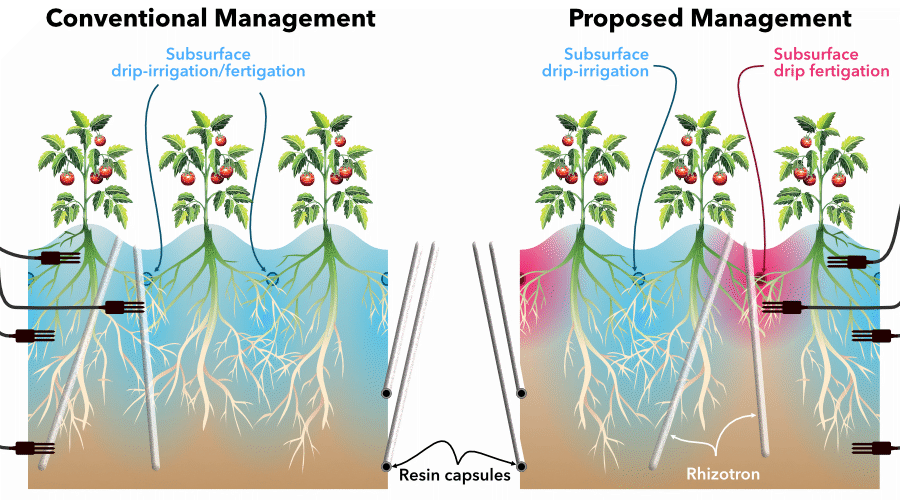January 01, 2022 by Teamrat A Ghezzehei
Nitrogen Management Grant
The California Department of Agriculture, Fertilizer Research & Education Program (FREP) funded our proposal to test a novel approach of irrigation and fertilizer management that promisses to curtail nitrigen loses below the root zone. This study is a collaboration with Dr. Khaled M. Bali and Dr. Tapan Pathak. Dr. Bali is Irrigation Water Management Specialist at UC ANR, Kearney Agricultural Research & Extension Center and Dr. Pathak is Climate Adaptation in Agriculture Specialist with joint appointments in UC ANR and UC Merced SNRI.
Executive Summary
Distributed Water and Fertilizer Delivery for Minimizing Nitrogen Losses by Leaching and Volatilization
T.A. Ghezzehei (PI), K.M. Bali (Co-PI), T. Pathak (Co-PI)
Location: UC Merced, UC ANR collaborators, and partner growers in the region
Objectives
The project responds to the Loss Pathways priority area. Specifically, we aim to conduct field testing of a novel and scalable Nitrogen and water management strategy that spatially separates the root zone into water-rich and nutrient-rich areas, thereby eliminating Nitrogen losses by leaching and volatilization.
Approach
Recently, our lab concluded a proof-of-concept greenhouse study (Fig 1a) that successfully demonstrated that tomato plants could acquire all their nutrient requirements from dry soil patches, provided sufficient moisture exists elsewhere in the root zone (Yan et al., 2020). Moreover, we demonstrated that such partitioning of resources does not cause a measurable difference in plant productivity, including flowering, fruits, and biomass, compared to control plants fed nutrient solution and irrigation water. This study demonstrated immense plasticity of root architecture to adapt to the specific nutrient and water distributions. Our findings suggested that the colocation of nutrients and water, which is the main driver for N loss by leaching and volatilization (Bowles et al., 2018), is unnecessary for maintaining productivity. Therefore, we propose spatially isolating the bulk of irrigation water from the applied Nitrogen can be useful in drastically cutting losses. Here, we propose conduct tests of water and nutrient management strategy that achieves the goal. The strategy involves separate drip irrigation lines for water and nutrients, as illustrated in Fig 1b. Water that meets the crops’ transpiration demand is delivered by drip lines installed every other row. The in-between rows are used for drip lines that deliver nutrients with a low amount of water. The concept is similar in design to a well-established partial root drying (PRD) method of irrigation practiced in arid regions, including Israel and Australia (Bielorai, 1982; Dry et al., 2000). In PRD, every other row is irrigated in an alternating schedule, whereas in our proposed strategy, water and nutrients are delivered to dedicated rows. This proposal is consistent with recent recommendations to utilize the integrative function of plant decision-making and self-regulation in the sustainable management of agricultural systems (Vetterlein et al., 2020). The benefit of this study is premised on two critical factors. First, as demonstrated by our recent study, separating water and nutrient availability to different parts of the root zone does not cost yield. Second, reducing the maintaining low moisture content in the nutrient-rich zone eliminates the potential for leaching and volatilization. The study will be carried out over three years so that we can test: (a) effectiveness of surface and buried drip irrigation for water and nutrients, (b) effect of recommended and reduced fertilization rates, and (c) retention and loss of residual nutrients between growing seasons. We will collaborate with UC ANR scientists in establishing suitable grower-partners. Plans for Outreach & Measurable Outcomes: The primary measures of success of this study are (a) whether the proposed strategy achieves the same level of yield as conventional methods and (b) whether a measurable decrease in leaching and gaseous losses and (c) whether the prevention of loss can be translated to reduced fertilizer application without commensurate loss of productivity. This study’s outcomes will be communicated via peer-reviewed articles, technical articles aimed at extension specialists and irrigation equipment engineers. In partnership with ANR, we will host field days, demonstrations and prepare educational videos and blog posts.

